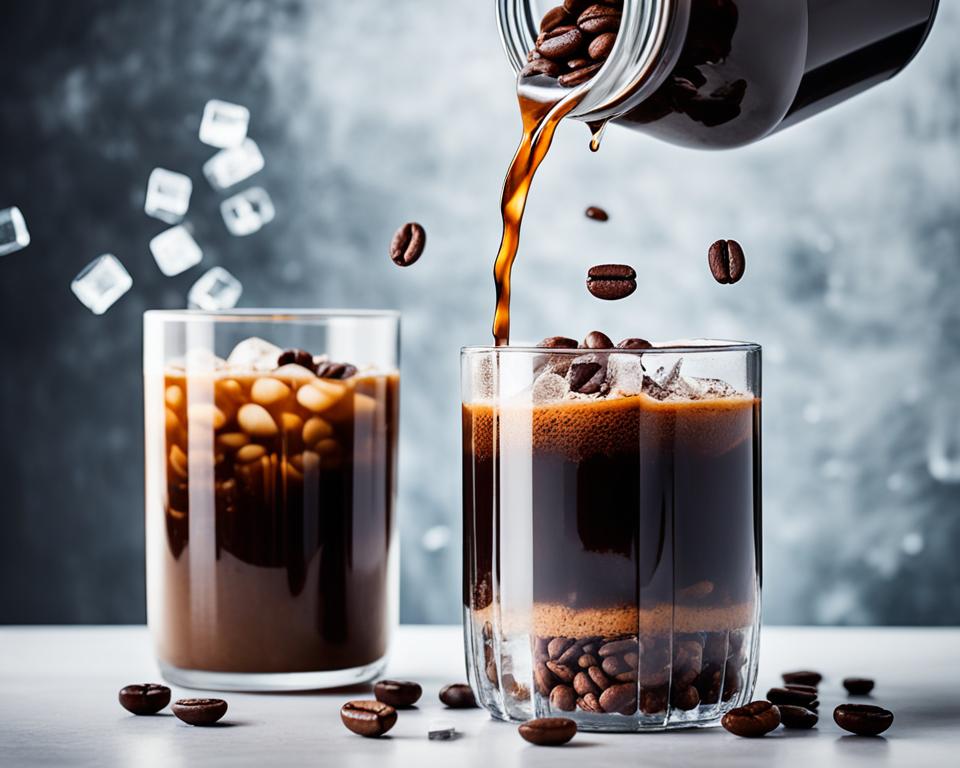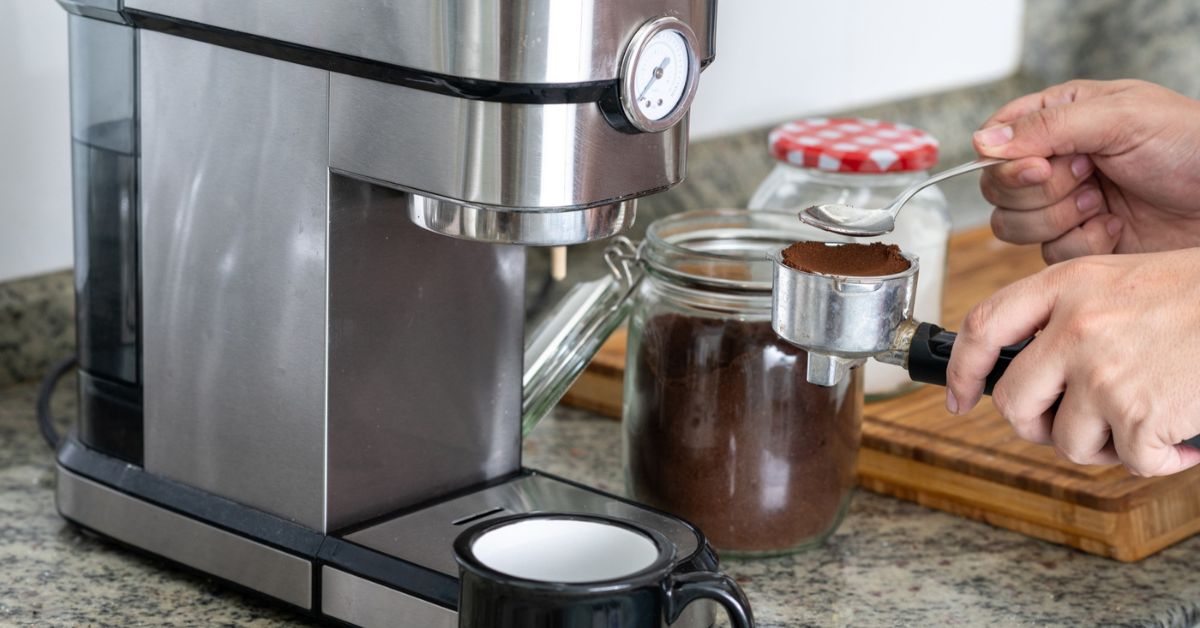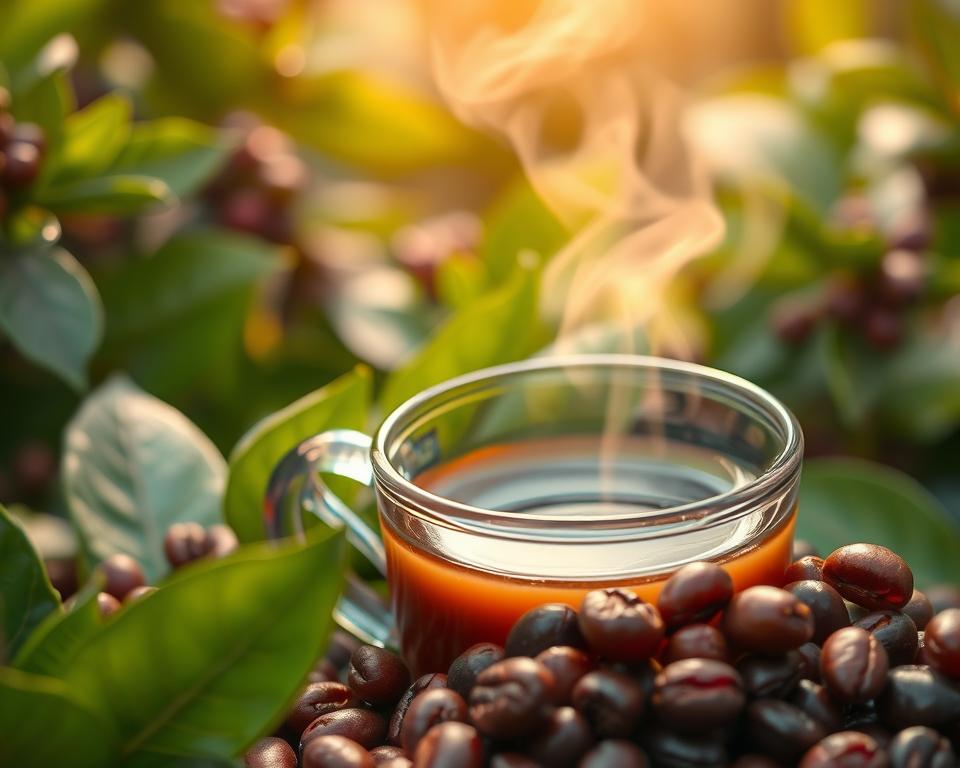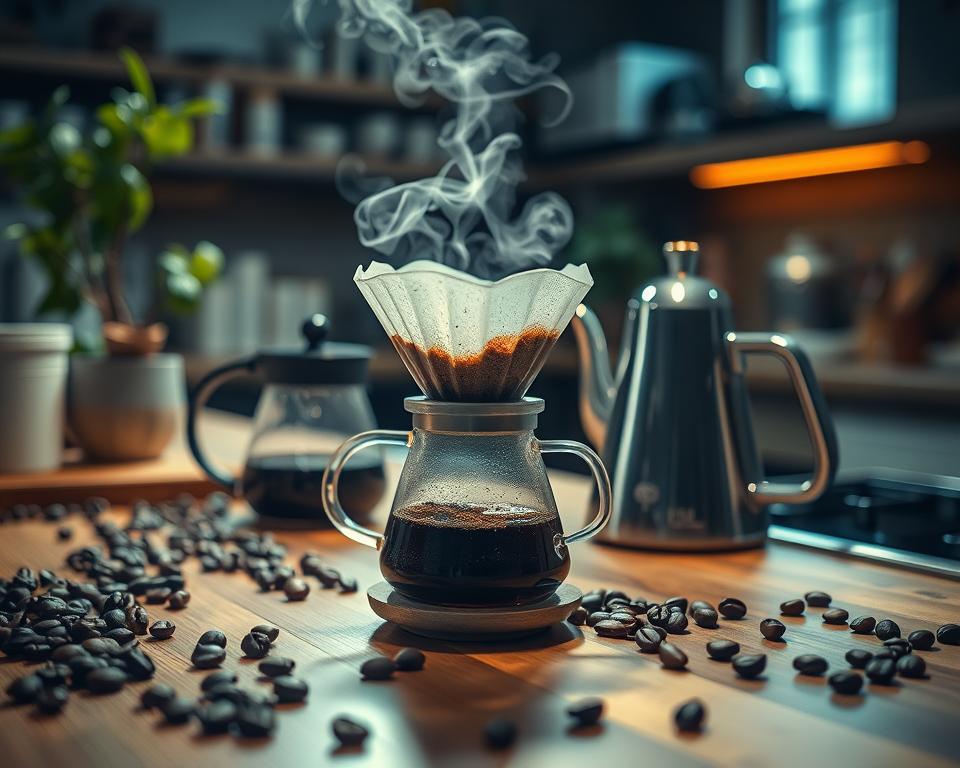Have you ever wondered why your cold-brew espresso at home doesn’t quite match that of your favourite café? Welcome to your cold-brew espresso guide.
There’s something magical about the perfect cold-brew espresso—its smooth, rich flavour makes it a treat any time of day. That’s why I’m excited to share my secrets for making this delicious drink right in your kitchen.
Creating homemade cold-brew espresso is simpler than you might think. With a few tips and an easy recipe, you’ll be crafting a brew that rivals any barista’s.
The convenience and unique taste profile of cold-brew coffee are unmatched, making it a favourite for coffee lovers everywhere.
Ready to dive in? Get your beans, and let’s start this delicious journey together. You’ll soon see just how fun and rewarding making your own cold-brew espresso can be!
The Basics of Cold Brew Espresso
Understanding the essentials of cold-brew espresso helps us appreciate its unique qualities. This method creates a smooth, flavorful drink by steeping coffee grounds in cold water for an extended period of time.
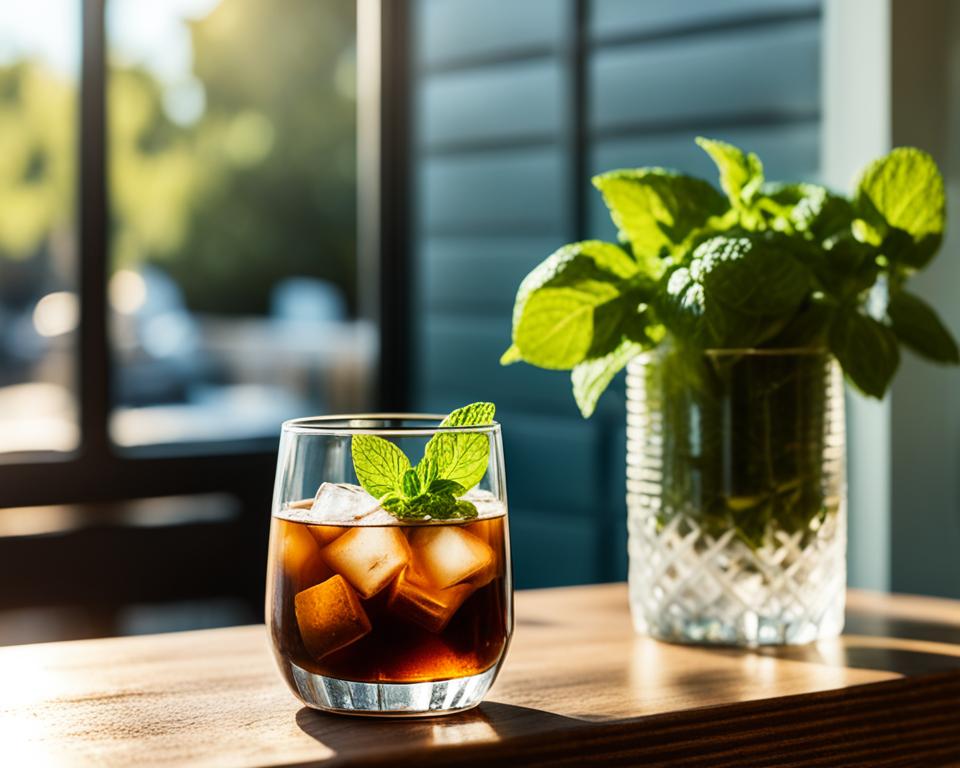
What is cold-brew espresso?
Unlike traditional hot espresso, which uses hot water and pressure, cold-brew espresso relies on time. Ground coffee is steeped in cold water for 12 to 24 hours.
This slow extraction process results in a rich, full-bodied flavour that’s less acidic.
Why choose cold-brew espresso?
There are many benefits to cold-brew espresso. It’s less acidic than its hot counterpart, making it gentler on the stomach. Plus, the long steeping time brings out subtle flavours often lost in hot brewing.
When comparing cold brew vs. hot espresso, you’ll notice that cold brew has a smoother, less bitter taste, perfect for those new to espresso or those who enjoy cold espresso drinks.
Choosing the Right Coffee Beans
Picking the perfect beans can make a world of difference in your cold-brew espresso. With so many options, how do you choose?
Go for fresh beans.
Always prioritise fresh coffee beans. Freshness directly affects the flavour and aroma of your brew. When beans are fresh, the oils and compounds that give coffee its distinct taste are more prominent.
I always check the roast date on the bag and aim for beans roasted within the last month. It definitely makes a noticeable difference.
Another tip is to buy whole beans and grind them just before brewing. Pre-ground coffee loses its freshness quicker. By grinding your beans at home, you ensure each cup is as fresh as it gets.
This simple step enhances your cold brew experience.
Pick the Right Roast
When deciding between a light roast and a dark roast, think about the flavor profiles you enjoy. Light roasts typically have brighter, fruitier notes, while dark roasts offer deeper, richer flavors.
For the best coffee beans for cold brew, I find that medium to dark roasts work best. They provide a robust, full-bodied taste that holds up well in a cold brew.
However, it’s all about personal preference. Experimenting with different roast levels can be a fun way to discover what you love. You might be surprised at how much a light roast vs dark roast can change your cold brew game.
Finally, consider your espresso bean selection carefully. Some beans are specifically grown and roasted to make excellent espressos, and these beans can also shine in a cold brew. Look for beans labeled as suitable for espresso to get a smooth, balanced flavor profile.
Remember, the journey to the perfect cold-brew espresso starts with the right beans. Happy brewing!
Essential Equipment for Cold Brew Espresso
Making the perfect cold-brew espresso at home starts with having the right tools. With the right cold-brew espresso equipment, the process becomes a breeze, and the results are impressive.
Grinder
The foundation of any great espresso starts with the grind. Using the best grinder for coffee will ensure that your beans are uniformly ground, which is essential for a consistent brew.
I recommend a burr grinder for the best results. It produces an even grind size, enhancing the extraction process.
Cold Brew Maker
Next, you need a reliable cold brew maker. There are plenty of cold-brew coffee makers on the market, ranging from basic models like the Takeya Cold Brew Maker to more advanced options like the OXO Brew Cold Brew Coffee Maker.
Choose one that fits your needs and budget. It should be easy to use and clean, making the brewing process hassle-free.
Filtering Tools
Filtering is a crucial step in making cold-brew espresso. Proper cold-brew filtering techniques will ensure that your coffee is clear and free of sediment.
You can use a mesh strainer, paper filters, or even fine cloth filters. Each has its pros and cons, but what’s important is removing the fine coffee particles that can make your coffee gritty.
With these tools, you’re well on your way to mastering the art of cold-brew espresso. From the right grinder to an effective cold brew maker and quality filters, having the right cold brew espresso equipment will make all the difference in your brewing experience.
Step-by-Step Cold Brew Espresso Recipe
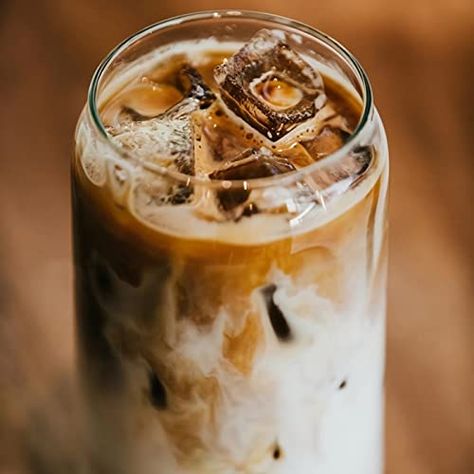
Cold-brew espresso
Ingredients
Method
- Grind Your Beans:
- Use a burr grinder to grind fresh coffee beans to a coarse consistency.
- Measure and Mix:
- Combine 1 cup of coarsely ground coffee with 4 cups of cold, filtered water in a jar or cold brew maker. Stir gently to mix.
- Brew Time:
- Cover the mixture and let it steep in the refrigerator for 12 to 24 hours. The longer it steeps, the stronger the flavor.
- Filter:
- Strain the mixture through a fine-mesh sieve or coffee filter to remove the grounds. For a cleaner brew, filter it twice.
- Serve:
- Pour the cold brew concentrate over ice. Dilute with water or milk to taste. Add sweetener if desired.
Notes
Making a homemade cold-brew espresso is easier than you might think. Let me walk you through simple cold-brew espresso instructions that will result in a rich, smooth, and refreshing drink.
- Grind Your Beans: Start with fresh coffee beans. You’ll want to grind them to a coarse consistency. This ensures significant flavor extraction while preventing over-extraction.
- Measure and Mix: Use a ratio of 1 cup of coarsely ground coffee to 4 cups of cold, filtered water. Stir the mixture gently to combine.
- Brew Time: Cover your mixture and let it steep in the refrigerator for 12 to 24 hours. The longer it steeps, the stronger the flavor will be.
- Filter: Using a fine-mesh sieve or coffee filter, strain the mixture to remove the grounds. You might need to filter it twice for a cleaner brew.
- Serve: Pour the cold brew espresso concentrate over ice and dilute with water or milk to your preference. You can even add a dash of sweetener if desired.
And there you have it! That’s how simple it is to make delicious cold-brew coffee at home.
These straightforward cold-brew espresso instructions should help you craft a beverage that’s perfect for hot days or just when you need a caffeine boost. With practice, you’ll have your personalized cold brew recipe perfected in no time!
Tips for Storing and Serving Cold Brew Espresso
Storing cold-brew coffee correctly is crucial for preserving its taste and freshness. I always recommend using an airtight container to keep it flavorful. A mason jar or a specialized cold-brew carafe works perfectly for this purpose.
When thinking about cold brew shelf life, it’s helpful to remember that your brew generally stays fresh for up to two weeks if refrigerated. To ensure you serve cold-brew espresso at its best, stick to this timeline.
How you serve cold-brew espresso can make a big difference in the experience. Serve it over ice for a classic, refreshing touch or blend it with milk for a creamy, smooth drink. These cold coffee serving suggestions will surely impress your friends and family.
If you’re like me and enjoy a bit of flair, try adding flavored syrups or a dash of cinnamon to your brew. Why not mix it up a little to discover your favorite way to serve cold-brew espresso?
Remember, the key to enjoying cold-brew espresso lies in proper storage and knowing how to serve it most appealingly. Happy brewing and serving!
Can I Use Cold Brew Espresso for Making Layered Irish Espresso Coffee?
Yes, you can use cold brew espresso for making layered Irish espresso coffee. This method enhances your drink with a smooth, bold taste. By blending the cold brew with Irish whiskey and cream, you can discover the rich flavors of layered espresso, creating a delightful twist on a classic favorite.
Conclusion
As we’ve journeyed through the delightful world of cold-brew espresso together, I hope you now feel equipped to master this refreshing coffee treat at home. Embracing the simplicity and rich flavors of homemade cold brew unlocks endless enjoyment for both daily rituals and special occasions.
The essence of a perfect cold brew lies in understanding its unique basics, selecting fresh, suitable beans, and having the essential equipment.
By following the step-by-step recipe provided, you can create your very own barista-quality cold brew at home. The benefits, such as its smooth taste and reduced acidity, are truly rewarding.
I encourage you to take these newfound tips and confidently embark on your cold-brew adventure. Remember, the joy of a cold brew is not just in drinking it but also in the satisfaction of creating it yourself.
Don’t hesitate to experiment and have fun with different serving styles. I hope you enjoy homemade cold brew as much as I do!
So, here’s to mastering cold-brew espresso and discovering more about the wonders it brings to our coffee experiences. Happy brewing!
FAQ
What is cold-brew espresso?
It is a coffee brewing method where coffee grounds are steeped in cold water for an extended period of time, usually 12–24 hours. This process produces a smoother, less acidic coffee compared to traditional hot-brewed espresso. It’s perfect for those who enjoy iced coffee but want a richer espresso flavour.
Why choose cold-brew espresso?
Choosing this espresso offers several benefits. It has a smoother and less acidic taste, making it gentle on the stomach. It’s also a convenient method for making large batches that can be stored and enjoyed over several days. Plus, it provides a refreshing alternative to hot coffee, especially in warmer climates or seasons.
Are fresh coffee beans important for cold-brew espresso?
Yes, using fresh coffee beans is crucial for achieving the best flavour in your cold-brew espresso. Fresh beans retain more of their original flavour compounds and oils, resulting in a more aromatic and flavorful brew. It’s always best to grind your beans just before brewing.
What roast level is best for cold-brew espresso?
The best roast level for this espresso depends on your taste preferences. A medium-to-dark roast is often recommended for a rich, full-bodied flavor. However, a light roast can also be used for a brighter, more nuanced taste. Experimenting with different roasts can help you find your perfect flavour profile.
What Equipment Do I Need for Making Cold Brew Espresso?
To make espresso, you will need a quality coffee grinder, a cold brew maker, and proper filtering tools. A burr grinder is preferred for a consistent grind size. Cold brew makers range from simple mason jars with filters to more advanced systems, and good filtration ensures a clean, sediment-free drink.
How Do I Make Cold Brew Espresso at Home?
Making espresso at home is simple. Start by coarsely grinding your fresh coffee beans. Mix the grounds with cold water in your cold brew maker or a jar, and let it steep in the refrigerator for 12–24 hours. Once the steeping is done, filter out the coffee grounds and enjoy your homemade cold brew!
How Should I Store Cold Brew Espresso?
Store your cold-brew espresso in an airtight container in the refrigerator. It will stay fresh for up to two weeks, though the best flavour is enjoyed within the first week. Make sure to filter it properly to avoid any sediment, and always keep it chilled.
What Are Some Serving Suggestions for Cold Brew Espresso?
Cold-brew espresso can be enjoyed in various ways. You can drink it straight over ice, dilute it with water or milk, or add some flavor syrups for a sweet treat. It also makes a great base for coffee cocktails. Get creative, find your favourite way to serve, and enjoy your cold brew!

